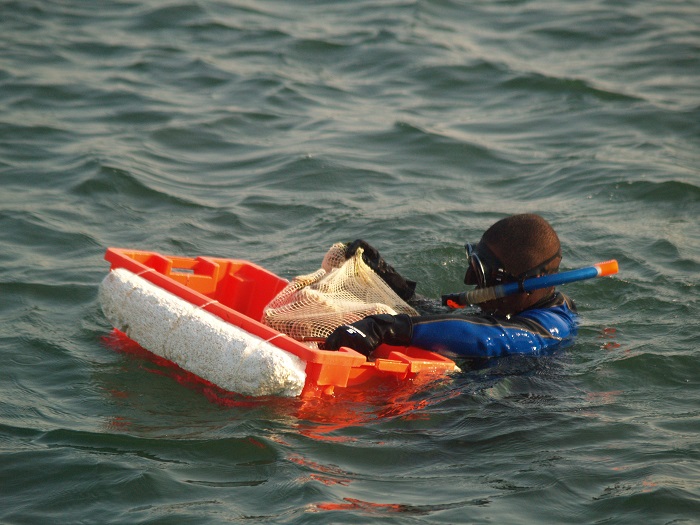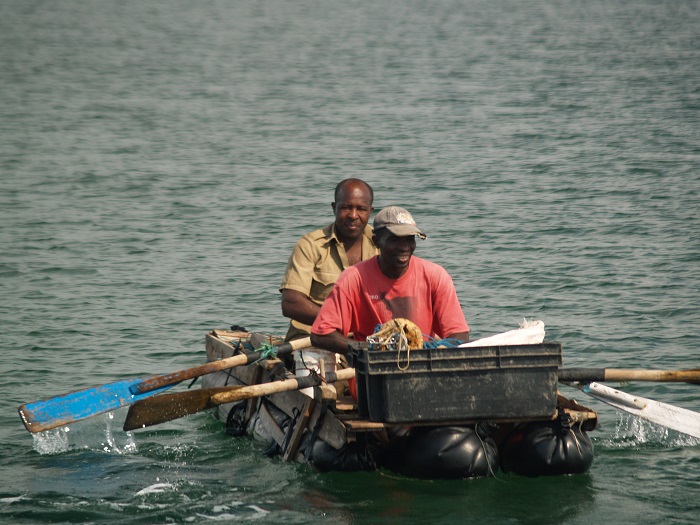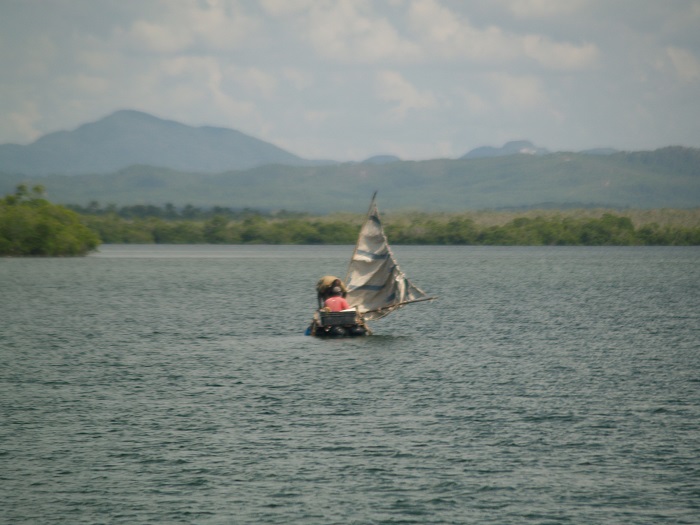Bob’s mother was notorious for invoking the saying “It’s always darkest before the dawn,” whenever anyone needed some cheering up. It’s uncanny how often that saying is true.
We’ve now had three very easy days of sailing and peaceful evenings at remote anchorages along the reefs and cayos in the Archipielago de los Colorados.
The morning after Bob’s visit with the fishermen we were all up about the same time. By the time Bob and I decided to up anchor, the crew, minus the captain, had donned full-length wet suits, and were jumping in the water with plastic bins tied to their waists on a long tether of wire. Considering what we’ve seen of fishermen, it has to be unusual for these men to have wet suits. The bins had a bit of Styrofoam on each side to help them float, and each man had his own bin. They made a circle around our boat, so that we could not leave. It was fascinating to watch them. They were picking up something that definitely wasn’t lobster or conch. Eventually one of the men’s bins was very close to us, and we could look down into the bin to see a healthy catch of sea cucumbers. Based on how often the men surfaced and threw a pile of these into their bins, they were having a very good catch of these creatures. We are guessing that these might get shipped to Japan. Still, I’m sure it’s the Cuban government who makes a good profit on these delicacies—not the men.
When the men moved off a bit we were able to up anchor and head out. Our destination was another Cayo Levisa, about 30 miles east. At the end of the day we stopped at Punta Alonso Rojas, which I thought was a cayo, but which turned out be a large clump of mangrove in the middle of the longest run of mangroves I have ever seen. It was most of our horizon! It looked like a series of islands, but on closer inspection each ‘island’ was a massive grove of mangroves. In fact, some of these mangrove areas looked like hills, but it turned out that there were very large mangroves in the middle that had to be over 75 feet tall with younger smaller mangroves growing outward from the giants. I had no idea they got that tall!
Just as Bob was putting the dinghy in the water so we could go ‘exploring’ a very small homemade fishing boat approached. Two men were rowing with homemade oars (I should mentioned that every row boat we’ve seen has had very rudimentary, homemade oars) on a boat made out of wooden slats, like a raft, with truck tire inner-tubes for floatation. The inner-tubes had been cut and straightened, then somehow tied closed at each end and filled with air. They must leak and need re-filling all the time, yet these guys had been out on the reefs all day and were returning home as the sun got lower. We bought two big lobster tails from them—again $5 CUC for both. Bob threw in a bar of soap –boy, was that the dumbest thing we brought along, based on very outdated advice from someone. So every day from now on we are giving out at least one bar of soap.
I happened to read The Boys in the Boat earlier during this trip, and I cannot help but compare the local fisherman here to the men who race rowing shells. I am convinced this sport must be about the hardest thing a body can do. When I see how far these fisherman row, in boats that do not skim the water easily, and with oars that are far from sleek, all the way out into ocean waters, no matter what the weather…well, I’m speechless. Crew is an amazing sport, but what these men do is just beyond comprehension to me.
Then the most amazing sight occurred. We were so impressed by the ingenuity and industry of these two men who fashioned a fishing boat out of a wooden raft with tire inner-tubes, yet that was nothing compared to what they did next. They raised a gaff rig sail made of dozens of pieces of scrap fabric. And I’d bet money those scraps had been sewn together by hand…it was an impressive sail made of years of leftover fabric scraps. They were running downwind on two inner-tubes with a sail from the rag bag, and it was quite a vision.
We took the dinghy to inspect the maze of little waterways between these mangrove ‘islands,’ and saw that the older plants in the center had huge trunks, as big as any maple or oak we’ve got at home. How old is a mangrove that big?? We threaded our way through lots of estuaries. It was fascinating how many mangrove ‘islands’ there are here. Each time we headed toward what we thought was finally going to be real island, perhaps even the place where the fishermen had returned home, but as far as we went it was all mangroves. There were miles and miles of shallow water supporting this mangrove forest. I don’t know how far those fishermen had to go to reach real land.
Since finishing the cabled sweater I’ve been inundated with ideas for projects. In one case I think I’ve improved on a project already underway. I’ve got yarn onboard that I was using to make a shadow knit sweater for one of my nieces. I was knitting the shadow stripes so they’d sit vertically on the sweater, and I was just beginning a funnel neck collar for the back when I set it aside a few weeks ago. Suddenly I just wasn’t that enthralled with my design. Then just after cabled sweater completion I had what I hope will be a brilliant idea to make an Einstien jacket (Sally Melville) out of the two yarns I was shadow knitting. I think that will be quite effective – vertical stripes below the empire waist and horizontal stripes for the bodice and sleeves, with fun buttons to gild the lily! It will be a classic shape, executed in a fun to knit structure. The bad news is that I don’t have the Einstein pattern onboard with me! Drat!



